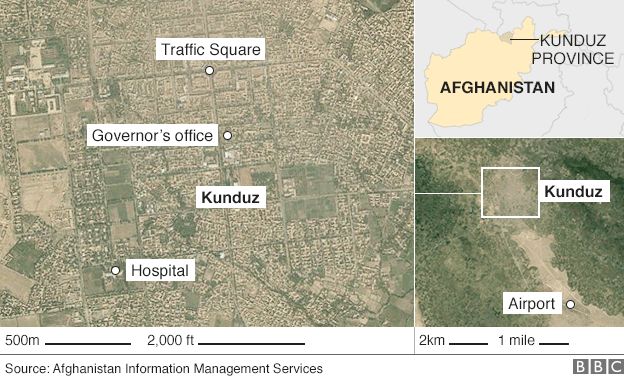Battleground Kunduz: The city the Taliban seized
-
9 hours ago
- From the sectionAsia
 Image copyrightAP
Image copyrightAPThe militant seizure of Kunduz has made the north-eastern city the site of one of the Afghan government's worst setbacks since Taliban forces were ousted in 2001.
One of Afghanistan's largest cities, it has long been a strategically important transport hub for the north of the country.
Kunduz is linked by highways to Kabul in the south, with Mazar-e-Sharif in the west and with Tajikistan in the north.
But it has always held symbolic significance for the Taliban because it was a key northern stronghold before 2001.
'Drug smuggling route'
Kunduz is considered a gateway to Afghanistan's northern provinces and shares a border with Tajikistan, Afghanistan's Central Asian neighbour.
The border with Tajikistan is porous, and it is used for the smuggling of Afghan opium and heroin to Central Asia, which finally finds its way to Europe.

Any side controlling Kunduz would not only influence the surrounding areas, but could also control one of the most important drug smuggling routes in the region.
Security for the region - which was a flagship project for the German army - was transferred to Afghan forces in 2013.
But Kunduz has many other problems: bad governance as well as incompetence and intimidation by some local officials have alienated many in the province.
It has long been at the frontline of a determined campaign by the Taliban to reclaim it. In May the BBC's David Loyn reported from there as fighting between government forces and the Taliban unfolded.
The Taliban already control huge chunks of the province's rural areas, where the majority of the population lives. The insurgents have intensified their fighting in the province over the past two years.
The city is estimated to have about 300,000 residents but those numbers are likely to be fluid because fighting prompted many to flee the city earlier this year.
Tens of thousands of people were displaced, living in shelters, spread across large tracts of countryside.
Although the insurgents were pushed back, they always had numbers in the region and many observers believed it was only a matter of time before a determined assault was attempted.



